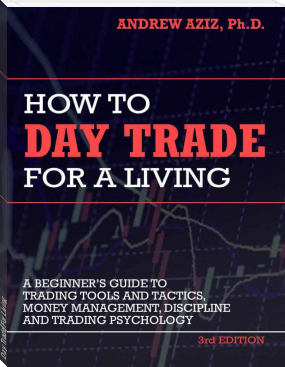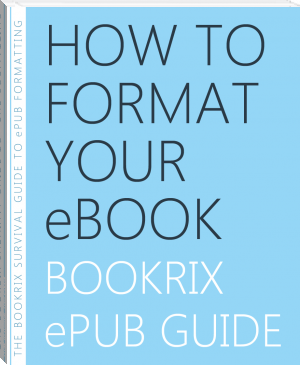Day Trade For Living by Andrew Aziz (epub ebook reader txt) 📕

Read free book «Day Trade For Living by Andrew Aziz (epub ebook reader txt) 📕» - read online or download for free at americanlibrarybooks.com
- Author: Andrew Aziz
Read book online «Day Trade For Living by Andrew Aziz (epub ebook reader txt) 📕». Author - Andrew Aziz
Do remember that brokers will give you 3 to 6 times leverage. If you put in $30,000, you're going to have $120,000 in buying power (a leverage of 4:1 in this case). That leverage is called the "margin", and you're allowed to trade on margin, but you need to be responsible about it. It is easy to buy on margin, but it is also very easy to lose on margin. If you lose on margin, your broker takes the loss from your main money account. Therefore, margin is a double-edged sword. It provides you an opportunity to buy more, but it also exposes you to more risk. There is nothing wrong with buying in margin, but you do have to be responsible.
Margin is like a mortgage for your house. You borrow a significant amount of money and buy a residence. Banks will give you a mortgage, but they won't take any responsibility or risk on it. For example, imagine that you put $100,000 down and borrowed $900,000 on a mortgage (10:1 leverage) from your bank to buy a $1,000,000 house. If the price of your house goes up to $1,200,000, you still owe the bank the original $900,000 plus their interest. So the extra $200,000 is your own profit that actually came from margin leverage. You couldn't have bought that house without mortgage leveraging. Now imagine that the price of the house drops to
$900,000. You still owe the bank $900,000 plus their interest, so the drop has hit your main $100,000 and you have lost all of your original down payment of $100,000. That is the other side of leveraging. Therefore, you need to be responsible about when and how much you use your account margm.
When a broker sees that you are using leverage and losing money, they might issue a "margin call" to you. A margin call is a serious warning and day traders must avoid getting them. It means that your loss is now equal to the original money you had in your account. You must add more money or else your broker will freeze your account. If you need to know more about margin, leverage or margin calls, check the broker's website, do some research on the Internet, or ask me or other traders in our private chatroom at www.Vancouver-Traders.com).
Trading Plaiform and Market Data
Fast trade execution is the key for day trader success. You need to be able to move in and out of trades quickly. If your broker doesn't use a software or platform that has hotkeys, you're not going to get in and out of trades fast enough. I can't tell you how many times I've been up a thousand dollars because all of a sudden the stock spikes. When stock spikes, you want to be able to put money in your pocket and profit from it quickly. You definitely don't want to be fumbling with your orders. You need quick executions, which is why I highly recommend a good broker and a fast order execution platform.
I use DAS Trader (www.dast rader.com) as my trading platform. DAS systems provide one of the most efficient execution solutions for online brokers, institutional trading desks and traders worldwide that demand smarter execution services.
On a literally 24/7 basis, I have found their support team incredibly helpful and competent. DAS servers are collocated with NASDAQ data centers. You cannot be any closer to the market for trading than this. DAS Trader is not a broker, but you can link your trading account to its platform for fast order execution. Some brokers will offer you the DAS platform when you open an account but IB has its own platform that I do not recommend. I have a subscription to DAS and they have linked my IB account to the DAS platform.
Watch List and Scanner
I talk to new traders almost every single day. I talk to hundreds of traders every month. One of the common themes among new traders is not knowing what to trade. Thousands of stocks are moving in the market every single day, but finding a setup that is both consistent and a good fit is really hard. I use Trade Ideas software (www.t rade-ideas .com ) for scanning the market and finding good trades. I explained my scanners and watch list building in Chapter 4 and I will explain in detail later in this book what I am looking for with my scanner as well as my trading strategies. You will also see some pictures of my scanner in the sections that follow. If you join our free private chatroom, you will see my scanner online in real time and will be able to observe how I use it.
Community of Traders
Trading alone is very difficult and can be emotionally overwhelming. It is beneficial to join a community of traders and ask them questions, talk to them if needed, learn new methods and strategies, get some hints and alerts about the stock market, and also make your own contributions. I personally trade in a private chatroom with some of my friends and family. We can talk to each other and everyone can view my live screen and platform and watch how I am trading. It is a fun, interactive environment, and we all learn from each other. I frequently answer questions from other traders, and if there is anything I'm not sure of, I will ask other traders. There are some experienced traders in our chatroom that I learn much from, and we tip each other off about potential good trades and setups. We would like to grow our chatroom slightly and therefore everyone who is reading this book is welcome to join with us. It is free, of course, and you will benefit from both watching me trade and hearing my responses to questions people have, including your own questions.
If you join me, you will see that quite often I lose money. It is always a good feeling to see that losing money is not just limited to yourself, but that everyone, including experienced traders, have to take some losses. It is part of the process. There are many chatrooms that you can join on the Internet. Some of them are free but most of them require payment. You can join our chatroom (of course for free) and see my screen in real time while I am trading and explaining my strategy. You can take trades with me, or just watch and listen. You can also take your own trades and still be part of my community. If you are interested in watching me or talking to me, check out our private chatroom at www.Vancouv er-Trade rs.com
It is extremely important to remember, however, that if you are in any community of traders, either our chatroom or the dozens of others that are out there, you should not follow the pack. You need to be an independent thinker. Generally, people change when they join crowds. They become more unquestioning and impulsive, nervously searching for a leader whose trades they can mirror. They react with the crowd instead of using their minds. Chatroom members may catch a few trends together, but they get
killed when trends reverse. Never forget that successful traders are independent thinkers. Simply use your judgment to decide when to trade and when to not.
Chapter 6: Introduction to Candlesticks
To understand my strategies in the next section, we need to quickly review price action and the fundamentals of candlestick charts. The Japanese began using technical analysis and some early versions of candlesticks to trade rice in the 17th century. Much of the credit for candlestick development and charting goes to a legendary rice trader named Homma from the town of Sakata, Japan. While these early versions of technical analysis and candlestick charts were different from today's version, many of the guiding principles are very similar. Candlestick charting, as we know it today, first appeared sometime after 1850. It is likely that Homma's original ideas were modified and refined over many years of trading, eventually resulting in the system of candlestick charting that we now use.
In order to create a candlestick chart, you must have a data set that contains (1) open price, (2) highest price in the chosen time frame, (3) lowest price in that period, and (4) closing price values for each time period you want to display. The time frame can be daily, I-hour, 5-minute, I-minute or any other period you prefer. The hollow (white) or filled (red) portion of the candlestick is called " the body". The long thin lines above and below the body represent the high/low range and are called " shadows" (also referred to as " wicks" and "tails"). The high is marked by the top of the upper shadow and the low by the bottom of the lower shadow. If the stock closes higher than its opening price, a hollow candlestick is





Comments (0)